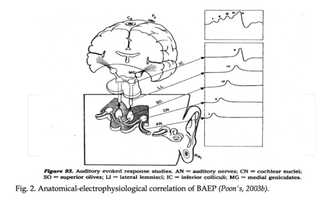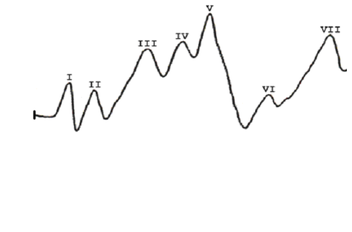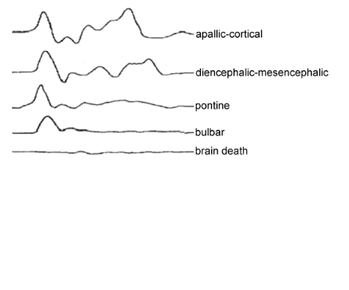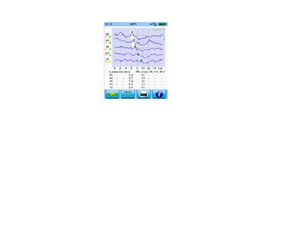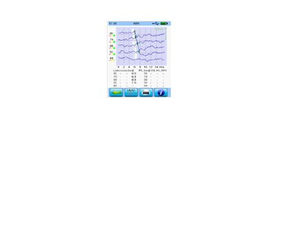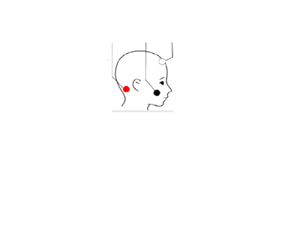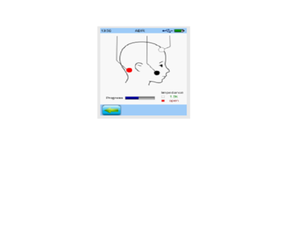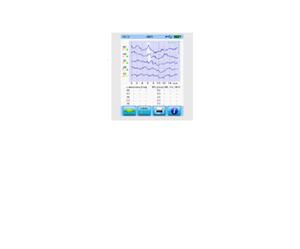Forum:Seminar papers/Biophysics/2. LF/2018-2019/Group 3/ABC
< Forum:Seminar papers | Biophysics | 2. LF | 2018-2019 | Group 3
|
Check of this article is requested. Suggested reviewer: Carmeljcaruana |
Evoked Potentials[edit | edit source]
Introduction[edit | edit source]
Evoked Potentials are electrical activities that occur in the neural pathways and structures as a response to external stimulations by light, sound, electricity or other stimulations. Evoked potentials are polyphasic waves (having more than two phases) that often present with an amplitude between 0.1-20 microV which are formed within 2-500 ms following the external stimulus.
Evoked potentials are used to show abnormalities in the function of nerve pathways that can be caused by neurological disorders. Examining evoked potentials can help us understand how quickly and completely the nerve signals reach the brain, help define the anatomic distribution, give some insight into and monitor the pathophysiology of a disease process and reveal changes in a patient’s neurological status.
There are three major types of evoked potentials used in clinical studies: Visual (VEP), Brainstem Auditory (BAEP) and Somatosensory (SSEP) Evoked Potentials.
On our seminar we will only discuss the Brainstem Auditory Evoked Potentials (BAEP).
Brainstem Auditory Evoked Potentials are the potentials recorded from the ear and vertex in response to a brief auditory stimulation. We assess the conduction through the auditory pathway up to the mid-brain.
Importance in clinical medicine[edit | edit source]
Purpose of an evoked potential test:[edit | edit source]
- To assess the function of the nervous system
- To aid in the diagnosis of nervous system lesions and abnormalities
- To monitor the progression or treatment of degenerative nerve diseases
- To monitor brain activity and nerve signals during brain or spine surgery, or in patients who are under general anesthesia
- To assess brain function in a patient who is in a coma
Brainstem Auditory Evoked Potentials[edit | edit source]
On applying auditory stimulus to one ear, activation of peripheral and central auditory pathways occurs. Brainstem auditory evoked potentials (BAEPs) are the electrical activities resulting from the activation of the eighth nerve, cochlear nucleus, tracts and nuclei of the lateral lemniscus and inferior colliculus.
Classical BAEP consist of 5-6 vertex positive peaks. The initial five peaks are of clinical interest. Peaks 6-7 are variable and mostly used in clinical psychology. The important features useful in the recognition of different waveforms are as follows:
On the graph you can see waves, which were detected from these anatomical areas:
- 1 wave: distal action potential of acoustic nerve
- 2 wave: ipsilateral proximal acoustic nerve(or/and cochlear nerve activity)
- 3 wave: ipsilateral superior nucleus olivarius activity
- 4 wave: lateral lemniscal nuclear or axonal activity
- 5 wave: inferior colliculus activity (mesencephalic)
- 6 wave: medial geniculate body activity (thalamic)
- 7 wave: thalamo-cortical projection activity (cortical)
Using BAEP we can indicate hearing loss, balance disorders, headaches, head traumas, tinnitus and etc.
BAEP studies assess conduction through the lower brainstem auditory pathways which are not readily accessible to other testing procedures. In clinical practice BAEP are used to investigate patients with possible multiple sclerosis, structural lesions of the brainstem and posterior fossa, intraoperatively to monitor integrity of the auditory pathways during neurosurgical excision of posterior fossa tumors, and as a guide to prognosis in post-traumatic and anoxic– ischaemic coma in the ICU. Occasionally hearing assessments are performed using electric response audiometry in patients who are unable to cooperate with formal audiometry. Abnormal results may also be due to: brain injury, brain malformation, brain tumor, central pontine myelinolysis, speech disorders, atherosclerosis and etc.
Literature Review[edit | edit source]
A brainstem auditory evoked potential (BAEP) is caused by an acoustic stimulus, i.e some kind of a sound, usually a series of clicks. The acoustic stimuli are transmitted from an acoustic transducer in the form of either an insert earphone or standard noise cancelling headphones. The stimuli generate a response, i.e., electrical signals, from the basilar region of the cochlea. The signal then travels along the auditory pathway from the cochlear nuclear complex to the colliculus (mid-brain). The cochlear nuclear complex carries information from the inner ear, the cochlea, and transmits it to higher regions of the auditory brainstem. The elicited waveform response is measured by surface electrodes typically placed at the vertex of the scalp and ear lobes. The amplitude, i.e., micro-voltage, of the signal is averaged and graphed against the time, in milliseconds. The graphs (waves) are recorded on an electroencephalogram (EEG) and examined. The waveform peaks, typically labeled I-V, usually occur within a 10-millisecond time period after an acoustic stimulus. Waveform I-II correspond to true action potentials, later waves may reflect activity in major brainstem auditory centers. The positive waveform peaks reflect combined sensory activity from axonal pathways in the auditory brainstem.
BAEP is a useful tool to evaluate conduction through the brainstem and the auditory nerve pathways that are not accessible by the means of other testing procedures. For example BAEP is used to assist in the diagnosis of hearing loss as well as detecting tumors and multiple sclerosis. BAEP also has the ability to inform the patient about lesions affecting the auditory nervous system.
Despite the advantages that Evoked potential provides, advancements in visual imaging limits the use of evoked potentials. Magnetic resonance imaging (MRI) today provides more benefits than Evoked Potential (EP) in imaging and structural issues, EG provides a more functional aspect and thus provides information regarding the physiology of the anatomical pathways. It also provides a more cost effective choice and BAEP can also be used in the monitoring of patients during neurosurgery and sometimes in the intensive care unit (ICU).
The BAEP testing procedure is painless and side-effects are very rare. The most common side effect is skin irritation, often by either the gel or the electrodes themselves. The degree of the irritation depends on the patient. But many factors may influence the evaluation of the response given, factors like hearing loss, asymmetry of hearing loss, test parameters, distractions and other patient factors. These factors must be factored in when performing and analyzing BAEP results.
Impedance[edit | edit source]
Impedance is opposition to AC current flow. Reactance is frequency-dependent. Because the EEG contains a strong AC signal, ERP researchers use impedance. In the context of EEG recording, the objective is to measure the impedance between the electrode and the highly conductive living skin tissue that immediately overlies the skull (i.e., the electrode impedance). It is usually done by passing a 10 Hz current between the electrodes to measure the opposition to the flow of this current. High level of impedance during the EEG measurement would lead to a high level of noise in t signal obtained during recording.
Interpretation of BAEP[edit | edit source]
Interpretation of the BAEPs usually involves measuring the absolute latency of the three most prominent vertex positive peaks I, III, and V, along with analysis of their relative inter-peak latencies (IPLs), which may provide some anatomical localisation of lesions. Conduction through the eighth nerve and the caudal brainstem is represented by the I-III IPL, while the III-V IPL probably represents transmission through the rostral brainstem and midbrain.
I wave: distal action potential of acoustic nerve
III wave: ipsilateral superior nucleus olivarius activity
V wave: inferior colliculus activity (mesencephalic)
Absolute latency: is the time interval between stimulus presentation and the point of maximal value (peak) of a defined component. It is expressed in milliseconds and represents the time taken by the stimulus information to generate the component.
Relative latency (inter-peak latency): is the time interval between two components and measures the conduction of the impulse between two generators.
Amplitude: vertical distance measured from the trough to the maximal peak (negative or positive). It expresses information about the size of the neuron population and its activation synchrony during the component generation.
| The results of a person with normal hearing | The result of a person with Conductive hearing loss |
| The stimuli range between 10-50 dB nHL.
As the stimulus levels decrease the Wave-V latency increases and the Wave-V amplitude decreases. The ABR is measurable down to 10 dB nHL. This shows that Wave-V latencies are within normal range. |
The Stimuli range between 40-80 dB nHL.
The Wave-V lat |
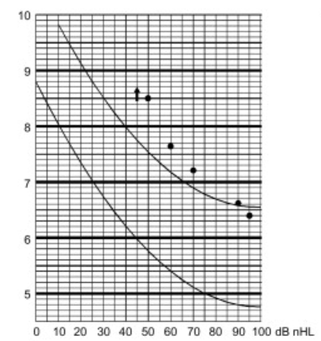
Equipment[edit | edit source]
1) Alcohol
2) Electroconductor gel
3) Machine to record brainactivity (Path Medical Sentiero// Advanced SOH06)
4) Headphones and electrodes to record brain activity
5) Example of the examination
Methodology[edit | edit source]
The Equipment that is used for the Evoked Potential experiment is the Path Medical Sentiero // Advanced SOH06.
- 1.) The Electrodes will be attached as shown:
Red Electrode: Mastoid Process, Black Electrode: Cheek & White Electrode: Forehead
- 2.) Prepare the skin by wiping the areas where the electrodes will be placed with alcohol.
- 3.) Then apply a layer of gel/Vaseline.
- 4.) Place the electrode patches on these areas.
- 5.) Attach the electrode clips to the electrode patches, according to their colour.
- 6.) Plug the ABR cable into the white jack of the machine.
- 7.) Place the electro-acoustic transducers (headphones) on the patient, making sure the red side is on the patients right ear and the blue side is on the left ear.
- 8.) Turn the monitor on.
- Enter patients name and details.
- Advise the patient to lay as comfortably as possible and to avoid any muscle activity.
- Press “ABR”(Auditory Brainstem Response).
- Then press “BAEP” (Brainstem Auditory Evoked Potential).
- Select CHIR 35 measuring mode
- Choose which ear will be tested.
- 9.) Electrode Impedance is checked before BAER measurement is checked.
- 10.) When this is complete the play button will appear. Press this button to start the measurement.
- 11.) When the BAER has been measured, the results will be displayed as shown below:
- 12.) The recorded traces will be displayed for each stimulus level (30, 50, 70 dB) together with normative areas if a normative data age group has been configured.
- 13.) If automated wave V detection has been activated the estimated wave V is shown as a dot on the trace.
- 14.) The latencies for wave I, III, and V can be adjusted by the user on the Jewett marker screen:
- The currently active marker is indicated by a circle
- The trace can be selected with the up/down arrow buttons
- The active marker can be moved along the selected trace with the right/left arrow buttons and can be set by pressing the set marker button. While moving the marker it is grey. When setting the marker it turns red or blue (for the right or left ear, respectively).
- The latency corresponding to the active marker and the resulting amplitude is shown as a numeric value below the ABR traces graph
- You can choose which Jewett marker (I, III, or V) you wish to change by pressing the Jewett marker selection button
- To accept any change in the position of the Jewett marker press OK button
- 15.) Press “Enter" to save results and to go back to regular ABR screen display. Record results.
- 16.) Take off electrodes and turn the monitor off.
Works Cited:[edit | edit source]
- “Electrophysiology - From Plants to Heart” edited by Saeed Oraii, 2012.
- Anbar, Michael & Spangler Robert A & Scott Peter “Clinical Biophysics”, Warren H. Green, 1991.
- Biomedical Signals Acquisition. (n.d.). http://www.medicine.mcgill.ca/physio/vlab/biomed_signals/eeg_erp.htm
- Chiappa, Keith H. “Evoked Potentials in Clinical Medicine 3d edition”, Lippincott-Raven Publishers, 1997
- Kappenman, E. S., & Luck, S. J. (2010, March 29). The Effects of Electrode Impedance on Data Quality and Statistical Significance in ERP Recordings. https://www.ncbi.nlm.nih.gov/pmc/articles/PMC2902592/#!po=0.370370
- Kouni, Sophia N , Constantinos Koutsojannis, Nausika Ziavra, and Sotirios Giannopoulos. "A Novel Method of Brainstem Auditory Evoked Potentials Using Complex Verbal Stimuli." NCBI. U.S. National Library of Medicine, 6 Aug. 2014. Web. Dec. & jan. 2016. https://www.ncbi.nlm.nih.gov/pmc/articles/PMC4158652/
- PATH MEDICAL GmbH. (8, September 2017). How-To-Manual Psycho-acoustical and physiological test procedures for the assessment of hearing impairment Scientific background, methodology, practical use. https://pathme.de/wp-content/uploads/pdf/epubli_printversion0802_MA_SentiSentiero_How-To-Manual_EN_05.pdf
- Paul Deltenre, Lionel Van Maldergem (2013). Auditory Brainstem Response. https://www.sciencedirect.com/topics/neuroscience/auditory-brainstem-response
- Walsh, P., Kane, N., Butler, S.. (2005, June). The clinical role of evoked potentials in Journal of Neurology, Neurosurgery & Psychiatry. Vol. 76,↵suppl. 2. ISSN: 1468-330X http://jnnp.bmj.com/content/76/suppl_2/ii16.full

